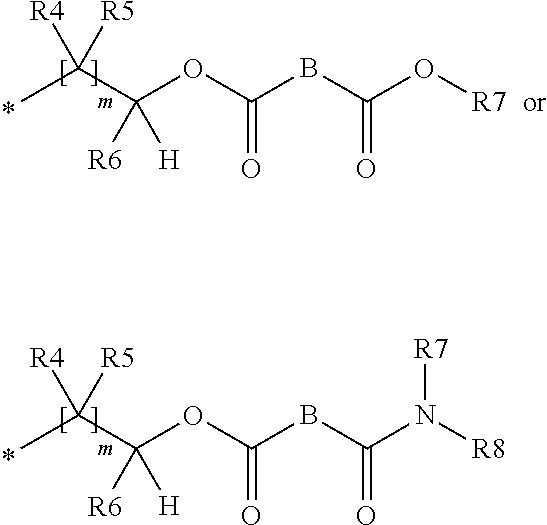Agent for treating hard surfaces
- Summary
- Abstract
- Description
- Claims
- Application Information
AI Technical Summary
Benefits of technology
Problems solved by technology
Method used
Image
Examples
example 1
Synthesis of Multi-Armed Silyl Polyalkoxylates
[0132](a) Production of a Hexa-Armed Triethoxysilyl-Terminated Polyalkoxylate
[0133]The starting material used was polyether polyol which is a hexa-armed random poly(ethylene oxide-co-propylene oxide) with an EO:PO ratio of 80:20 and with a molecular weight of 12,000 g / mol and was produced by anionic ring-opening polymerization of ethylene oxide and propylene oxide using sorbitol as initiator. Before being further reacted, the polyether polyol was heated to 80° C. for 1 h under a vacuum with stirring. A solution of polyether polyol (3 g, 0.25 mmol), triethylenediamine (9 mg, 0.081 mmol) and dibutyltin dilaurate (9 mg, 0.014 mmol) in 25 ml of anhydrous toluene was initially introduced and a solution of (3-isocyanatopropyl)triethoxysilane (0.6 ml, 2.30 mmol) in 10 ml of anhydrous toluene was added dropwise thereto. Stirring of the solution at 50° C. was continued overnight. After removal of the toluene under a vacuum, the crude product was ...
example 2
Toilet Reactor Test with Individual Polymers and Polymer Mixtures
[0138]The preventive action of various polymers with regard to biofilm reduction as a function of their concentration in a conventional commercial toilet cleaner was investigated in a realistic, dynamic system. The preventive action of the individual polymers was additionally compared with the action of mixtures of these polymers.
[0139]The “toilet reactor” replicates the flushing cycles of a toilet and thus the periodic wetting and drying of ceramic surfaces.
[0140]This system makes it possible to investigate adhesion and biofilm formation in a test system on several different surfaces over a defined period of 48 h. Instead of the water used in a real toilet, it is fresh medium (TBY 1:50) which is passed over the glazed tiles.
[0141]The reactor is initially filled with 680 ml of medium and inoculated with a microbial mixture consisting of Dermacoccus nishinomiyaensis DSMZ 20448, Bradyrhizobium japonicum DSMZ 1982 and Xan...
example 3
Verification of the Biocidal Properties of the Polymers
[0149]The biocidal properties of the individual polymers were investigated to standard DIN-EN 1276 on Staphylococcus aureus, Enterococcus hirae, Pseudomonas aeruginosa and Escherichia coli.
[0150]The biocidal properties were then compared with the biorepulsive properties of the polymers, which were determined as described in Example 2.
[0151]Glazed tiles, which were treated at the outset with water, were used as the reference in order to ascertain biofilm reduction by the toilet cleaner itself.
[0152]With regard to biorepulsive efficacy, the toilet cleaner with addition of the polymers Hydrostellan, DSM Hybrane Quat or DSM Hybrane 5000 in each case exhibited an approx. 70% increase in biofilm reduction. The biocidal action of the various cleaning product formulations, on the other hand, was very largely maintained. Both the 80% cleaning product / polymer formulations under ‘clean’ and ‘dirty’ conditions, and the 10% formulations und...
PUM
| Property | Measurement | Unit |
|---|---|---|
| Time | aaaaa | aaaaa |
| Covalent bond | aaaaa | aaaaa |
Abstract
Description
Claims
Application Information
 Login to View More
Login to View More - R&D
- Intellectual Property
- Life Sciences
- Materials
- Tech Scout
- Unparalleled Data Quality
- Higher Quality Content
- 60% Fewer Hallucinations
Browse by: Latest US Patents, China's latest patents, Technical Efficacy Thesaurus, Application Domain, Technology Topic, Popular Technical Reports.
© 2025 PatSnap. All rights reserved.Legal|Privacy policy|Modern Slavery Act Transparency Statement|Sitemap|About US| Contact US: help@patsnap.com



